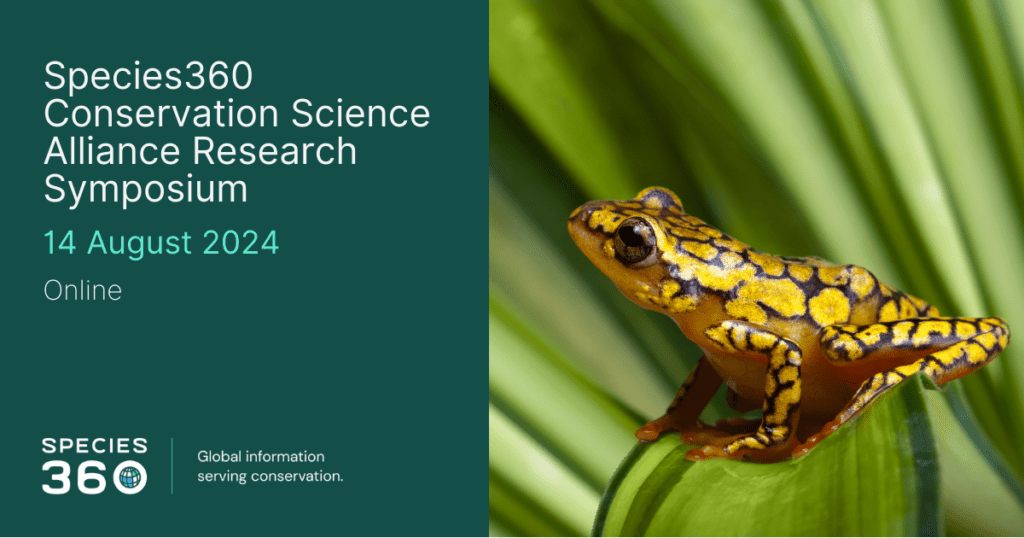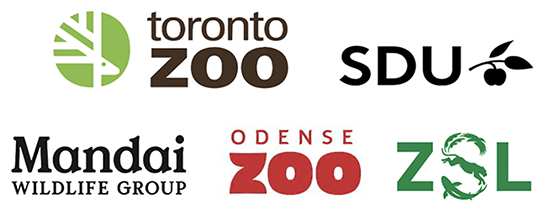
The Species360 Conservation Science Alliance (CSA) is thrilled to host its upcoming Research Symposium, where leading scientists and researchers from around the globe will gather to share their groundbreaking research utilizing data from the Zoological Information Management System (ZIMS).
Details
When: 14 August 2024
Time: 4pm CET / 9am CDT (Check the time in your region here)
Registration: https://bit.ly/2024CSAResearchSymposium
Presentation Abstracts
As we anticipate the symposium, we’re excited to share abstracts from the presentations that will be featured:
An adaptive management approach for the Regent Honeyeater Conservation Breeding Program
Dr. Joy Tripovich, Taronga Conservation Society/University of New South Wales
The Regent Honeyeater (Anthochaera phrygia) conservation breed for release program forms an integral component of the species recovery program with over 400 zoo-bred birds released into the wild. Recent Population Viability Analysis identified the need for an increase in the cohort size of future releases of zoo-bred birds, to bolster the wild population, coupled with intensive nest protection in remaining breeding sites, as a strategy to avoid extinction within the next 20 years. Using Species360 ZIMS and post release data, we have conducted reviews examining the husbandry practices and zoo-life history experience of released Regent Honeyeaters from eight releases on the east coast of Australia. The evidence generated from these reviews has informed the adaptive management strategy for the zoo-based breeding program. In addition, we have developed a data platform to capture a birds’ journey from birth to post-release and beyond. The data platform is providing the capacity for the development of such tools as the ‘release candidate optimiser’ tool, which will aid in the identification of fitter individuals for release and, more broadly, the data platform provides greater capacity for future conservation research. This research program highlights scope to enhance to the ZIMS platform that would be beneficial for program management incorporating in-situ and ex-situ data to drive conservation planning. Further, the presentation details the complexity of an evidence-driven, adaptive management approach to conservation breeding, and the primary goal of an integrated ‘One Plan’ approach to species recovery.
Using the past to inform the present and predict the future: utilizing ZIMS data to understand changes in animal collections over time
Dr. Megan Brown, Association of Zoos and Aquariums
Over the past 50 years, the zoological profession has demonstrated significant evolution across all aspects of animal care and management ex situ, especially in terms of population management, animal care, exhibit design, and a focus on animal wellbeing. Many long-term professionals in this field suggest that we are collaboratively managing fewer species now compared to species’ diversity of the past, and that these species are being managed in smaller populations. This is counterintuitive to our profession’s goal of maintaining as many species as possible in sustainable populations. We used animal holding data reported though Species360’s Zoological Information Management System (ZIMS) from the period of 1970 to 2020 to examine changes in species diversity and population size in facilities accredited by the Association of Zoos & Aquariums (AZA) across seven orders of mammalian species. We predicted declines in both overall species’ diversity and individual population sizes over time, and expected these effects to be uneven across species. We also developed a list of possible influences on zoo mammal collections and their associated start dates and charted these against species diversity and population size in order to understand which may have influenced changes in zoological collections. We considered the advent of coordinated breeding programs (Species Survival Plans® in AZA), initiation of formalized population and reproductive management, the trend towards more naturalistic exhibits, relevant changes in the regulatory environment, and other factors. In this presentation, we’ll review the trends observed and their possible influences.
Longitudinal analysis of threatened eastern massasauga rattlesnake (Sistrurus catenatus) body growth rates using ZIMS to inform conservation programs
Dr. Devin Chen, Toronto Zoo
The eastern massasauga rattlesnake (Sistrurus catenatus) is threatened across its range in North America, with the Carolinian subpopulation in Ontario at near extirpation. This has led to the establishment of a conservation breeding and reintroduction program as part of the eastern massasauga Species Survival Plan. Successful breeding and wild releases of animals rely on important demographic information such as growth rates, which can impact reproduction and survival. While growth rates of wild massasauga rattlesnakes have been recorded, analysis of individuals in zoos is lacking. This study aimed to determine zoo-housed eastern massasauga rattlesnake growth rates using longitudinal data from the ZIMS database. A total of 51 males and 61 females born since 2000 across 23 institutions were assessed to evaluate growth rates at different life stages (0-11, 12-35, 36-71, ≥72 months old). Through generalized additive modeling, we found that the 12-35mo period had significantly (p<0.0001) higher growth rates than all other stages, and within this stage, females (9.5±4.3g/month) grew faster (p<0.05) compared to males (8.5±2.7g/month). There was no effect (p>0.05) of individuals being wild versus captive-born on growth rates at any stage. Institutions where snakes were held had a significant (p<0.05) effect on growth rates, specifically at early life stages. These results show similar patterns to growth rates of eastern massasaugas in the wild, where females have faster initial growth compared to males. This information can serve as a reference for zoos to better maintain eastern massasauga rattlesnake health and well-being, especially for growing juveniles in breeding or reintroduction efforts.
Adult sex ratio in captive amniotes: is it related to the sex-determination systems?
Borbála Kocsis, University of Pannonia/Budapest Zoo & Botanical Garden
The adult sex ratio (ASR, the proportion of males in the adult population) is one of the most basic demographic characteristics of populations. However, little is known about the causes of its interspecific variations. In wild tetrapods, the genetic sex-determination system (GSD system) has been shown to predict ASR: taxa with female heterogametic sex chromosome system (ZW) have more male-biased ASRs than taxa with male heterogametic sex chromosome system (XY). If sex chromosomes influence ASR, then the GSD effect may persist across different environments, for example, it can influence the ASR of animals in human care. In this study, we test this prediction by using demographic data of captive amniotes from Species360 database, investigating ASR variation in 1480 species that have either female heterogametic (ZW), male heterogametic (XY) or temperature-dependent (TSD) sex chromosome systems. Our results show that captive ASR appears to be affected by the GSD system because we found significant ASR differences between ZW and XY species; female heterogametic species have more male-biased ASR, than female heterogametic species. Our results also show a significant difference between ZW and TSD species, female heterogametic species showing more male-biased ASR than TSD species. These findings support our prediction, that the GSD system influences the variations of ASR not just in the wild, but also in captive amniotes, or that no other factors mask its effects on animals in zoos.
Contemporary genetic adaptation in zoos and conservation breeding programs
Dr. Drew Sauvé, African Lion Safari/Université du Québec à Montréal
Conservation breeding is vital for combating biodiversity loss, but optimizing breeding programs is crucial for success. Genetic adaptation to the conservation breeding environment is often a suspected factor contributing to reintroduction difficulties, yet it remains largely untested. Using an extensive dataset from Species360 ZIMS, we assessed adaptive genetic change in 32 vertebrate populations, marking the broadest estimation of additive genetic variance of fitness across species to date. Our findings indicate widespread adaptive genetic change in zoo and conservation populations, with estimates comparable to those in the wild. While this adaptation may enhance fitness in captivity, concerns arise regarding genetic divergence and reintroduction success. Our results confirm the importance of anthropogenic effects on short-term species evolution and highlight the need for more studies to ensure ex situ populations can fulfill their potential in conservation strategies.
How Species360 substantially contributes to the build-up of the ‘conservation zoo’ – zoos as One Plan Approach conservation centres acting as modern arks
Dr. Thomas Ziegler, Anna Rauhaus, Cologne Zoo
We live in a time of global crises, thus targeted conservation action is a priority. For IUCN‘s One Plan Approach to Conservation, which is the development of management strategies and conservation actions by all responsible parties for all populations of a species, whether inside or outside their natural range, this also implies optimized use of zoo resources / collection planning. According to the idea of a species conservation zoo (as a modern ark), space, expertise, time and money should primarily be allocated to the species that need ex situ support the most. Once a species is extinct, it is too late, but if it is still in zoos, it can be reintroduced later. Using ZIMS you can examine animal groups or regions for taxa already kept and bred and also determine the proportion of endangered versus not threatened species in zoos; and furthermore, which species are represented in too high or too low numbers or in unfavorable gender combinations. This indicates what has already been achieved by zoos through ex situ protection and shows the gaps in ex situ species protection still need to be filled. Non-threatened species can then be replaced by threatened species that can be kept under similar conditions. In order to provide more threatened species with ex situ protection, exchange can take place between institutions, stocks can be genetically examined for previously overlooked taxa, confiscations can be converted into breeding programs or cooperations can be built up with partners in the countries of origin. We have already performed such analyses for certain regions, for animal groups or specific taxa.
Register here: 2024CSAResearchSymposium








